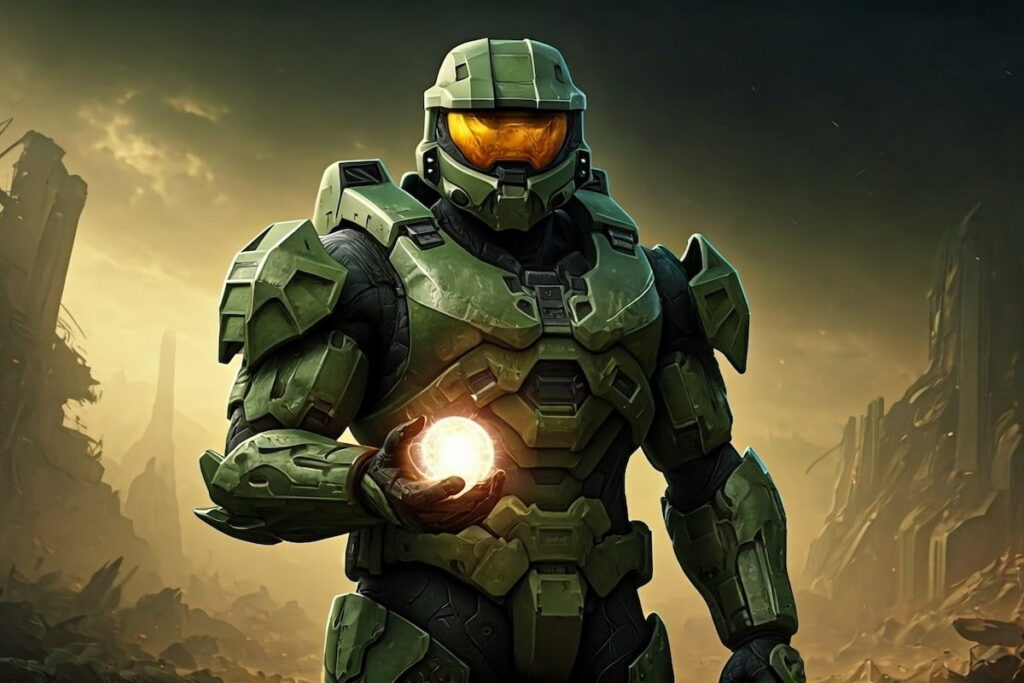There’s a moment you sit down, just before the game starts. You feel it. That rush of excitement in knowing that, for a time, anything is possible. It’s anticipation for a mix of everything we know to be on offer from a game, from the story right down to the soundscape. And we owe that to video game design.
Let’s take a look at the blueprint behind the magic, and how future video game designers can make us dream.
What makes a video game design the best?
The success of a video game depends on its design. We hear/read/watch plenty of in-depth reviews on graphics and performance. But the overall video game design shapes how we, the players, interact with the game. At its heart, game design is about shaping the player’s journey through storytelling, gameplay mechanics and progression to keep players immersed. When done right, it feels effortless—but it’s the result of intentional decisions that enhance flow, challenge and reward.
To become a skilled game developer, it’s important to understand and apply core game design principles. Without them, even the most visually impressive game can feel dull or frustrating. Fun isn’t guaranteed. It’s crafted.
How does video game design influence the gaming industry?

We’re now seeing video game design influencing the industry’s use of emerging technologies. Things like AI are now transforming creative production, economics and accessibility. That’s because game development is getting faster and cheaper, thus lowering entry barriers and leading to a flood of new content. And it’s fueling a market split between mass-produced, low-margin “toilet paper” games and high-risk, high-reward “luxury” indie titles. Because design itself can be fast-tracked, we’re seeing a broad impact on content style. And the growth of non-experts in the medium therefore changes the workforce amid a flux of supply-demand dynamics across the entertainment industry.
5 examples of great overall video game design
It’s always good to have a reference point when talking about the best video game designs. So, here’s a selection of titles that are worth studying for potential designers, pointing to a range of USPs across genres.
1. Doom (2016)
It has fast-paced, brutal gameplay with fluid movement, satisfying combat and clever level design. With a carefully designed balance between accessibility and depth, Doom is a pin-up for good gaming. Core mechanics like Glory Kills for health and Chainsaw Kills for ammo keep the action aggressive and up-close, while weapon variety and upgrade systems add layers of strategy. It’s an immersive experience that empowers players through the fantasy of power and mastery.
2. Portal 2
There are few contenders as good as Portal 2 when it comes to accessibility. Movement, interaction and puzzle-solving are introduced gradually for easy onboarding, with no real risk of failure early on. Beyond that, there’s a holistic balance of environmental design, visual cues and humor that make it easy to absorb the rules naturally. Instead of rewarding button presses, the game rewards the solving of puzzles. With witty dialogue and charming characters, Portal 2 incorporates a smooth design that makes it a delight to play.
3. Assassin’s Creed
The world-famous Assassin’s Creed saga is something of a masterclass in evolving game design. The creators have seamlessly blended historical settings with innovative mechanics to make something truly unique. Who wouldn’t be seduced by its mix of stealth, parkour, open worlds and intricate storytelling? The whole thing feels perfectly intuitive and cinematic, while careful onboarding and visual cues teach complex systems without overwhelming the player. Assassin’s Creed is the case study for deep worldbuilding.
4. Grand Theft Auto IV
Another pop-culture giant: Grand Theft Auto IV. The designers committed to realism in the narrative, creating a gritty, immersive world that feels alive. The NPCs of Liberty City live in a detailed world, complete with weather systems and varying urban density. In terms of mechanics, the cover-based combat and weighty driving physics show a deliberate shift toward a more mature, grounded experience. GTA IV is a landmark in 360-degree design for a believable, character-driven open-world experience.
5. The Legend of Zelda: Ocarina of Time
This one gets the emotions going. The narrative is perfectly paced, leading players through thoughtfully crafted dungeons for contained challenges. The innovative use of time travel enriches exploration and puzzle-solving, making the world feel dynamic and interconnected. And the cutscenes work well to keep fostering player investment. Together, these design choices build an epic coming-of-age adventure that remains timeless in the industry.
What are the principles of video game design?
Let’s deconstruct the concept of video game design a little more. What we’re looking for is a balance of various metrics. To summarize, they would be mechanics, interaction, balance, motivation and storytelling. And it’s not just about how well they work in isolation—they need to blend into one experience.
1. Mechanics
Core game mechanics are the essential rules and systems that drive how a game functions. We’re talking movement, combat, puzzle-solving—anything that makes the game move. Designers have to make sure mechanics keep gameplay engaging and purposeful.
2. Interaction
This is how players engage with the game. This can include exploration, puzzle-solving, dialogue choices or teamwork in multiplayer. Meaningful interaction deepens immersion and makes the game feel more responsive and rewarding.
3. Balance
Balance and fairness keep us short-tempered gamers from ragequitting. It keeps the game fun and challenging without becoming frustrating. Well-designed games gradually increase difficulty, offer fair checkpoints and support multiple strategies, giving all players a chance to succeed.
4. Motivation
How do you make us want more? Rewards? Progress? Feedback? We need it all to keep coming back. Positive or negative loops help maintain challenge, while clear goals and recognition—like achievements or new gear—encourage continued play.
5. Storytelling
This one’s the poster-boy for what we consider the best video game design. Great storytelling blending narrative, visuals, sound, character and interaction. Instead of heavy exposition, the story unfolds naturally through environments and dialogue that keep us hooked.
What are some examples of the best video game sound design?
It might not get all the plaudits when we talk about video game design, but good sound design is crucial. No matter the genre, good sound is an invisible, life-giving force.
Let’s take horror games, for example. Carefully timed audio cues—like static, distant footsteps or unsettling ambient noises—heighten our sense of vulnerability.
Games like Silent Hill 2, Resident Evil 2 and Dead Space are perfect cases for the power of good video game sound design in horror.

Looking beyond, genres like rhythm and racing need the sound to drive things forward. Naturally, the success of Guitar Hero and Beat Saber hinge on an intricate sound design that fits with the gameplay. Similarly, racing games like Forza Horizon and Mario Kart use noises to enhance that sense of speed that keeps everything ticking.
Even in puzzle and stealth games, sound plays a subtle yet essential role. Stealth games like Metal Gear Solid and Dishonored use audio to communicate enemy presence and consequences, while puzzle games such as Portal 2 and The Witness use sound to provide clues, feedback, and emotional tone. Across all genres, thoughtful sound design enhances gameplay, storytelling and the overall emotional experience.
Which video games have the best character designs?
There are some characters that really stay with you. They’re our vessels for player projection, and great characters can leave a lasting cultural impact beyond gameplay. Take Samus Aran, whose surprise gender reveal at the end of Metroid challenged assumptions in an era dominated by male protagonists. Or Pac-Man’s appeal to broad audiences with simple shapes, colors and sound. Sonic the Hedgehog and Super Mario have gone on to have their own films, proving that memorable characters in engaging stories can drive success.
It’s not all about being distinctive. Halo’s Master Chief is the blank slate that players need to project themselves into a narrative.

These iconic characters remind us that how a character plays, feels and evolves can be just as powerful as how they look.
What are the best schools for video game design?
Interested in studying video game design? You should definitely consider IE School of Architecture & Design in Madrid. Our (Mdes) Master in Videogame Design & Virtual Environments is a unique, 10-month program that combines creative, technical and strategic training. It’s designed for forward-thinking individuals passionate about game design, virtual environments, and cutting-edge technologies like XR, real-time graphics and AI.
Unlike many traditional programs, its curriculum places equal emphasis on design innovation, sustainability and entrepreneurship. Students collaborate across disciplines, engaging in studio-based projects from day one, supported by IE’s Design Innovation Platform. Courses cover not only technical skills but also business, communication and social impact—giving you a versatile foundation to succeed in a rapidly changing industry.
The program is tailored for creatives, tech professionals, and entrepreneurs seeking to lead the future of games, virtual worlds and interactive media.

Graduates emerge not just as game designers but as well-rounded professionals ready to lead in diverse roles such as game producer, art director, product manager or creative director. With strong global networks, real-world projects and access to cutting-edge tools and labs, we’ll put you at the forefront of a highly competitive industry. Follow the link below to find out more information.
Study the (Mdes) Master in Videogame Design & Virtual Environments
Discover an innovative and practical education at IE School of Architecture & Design.

Benjamin is the editor of Uncover IE. His writing is featured in the LAMDA Verse and Prose Anthology Vol. 19, The Primer and Moonflake Press. Benjamin provided translation for “FalseStuff: La Muerte de las Musas”, winner of Best Theatre Show at the Max Awards 2024.
Benjamin was shortlisted for the Bristol Old Vic Open Sessions 2016 and the Alpine Fellowship Writing Prize 2023.






